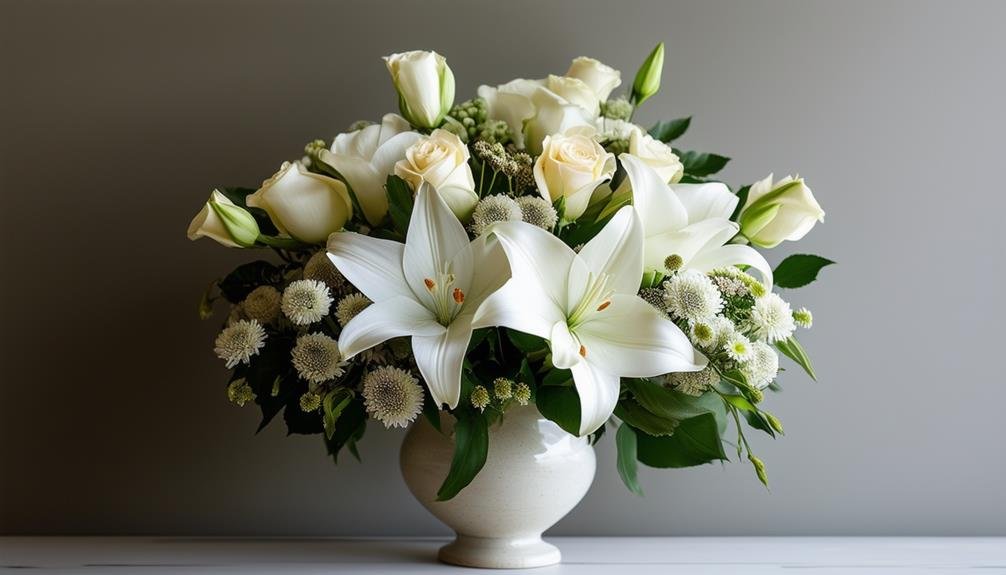Selecting suitable funeral flowers involves understanding
floral etiquette,
symbolic meanings, and
cultural customs. Commonly chosen flowers include lilies for innocence, roses for love and respect, and chrysanthemums for tribute. Different colours convey specific sentiments: white symbolises purity and peace, red denotes deep affection, while yellow and blue represent warmth and tranquillity. Cultural and religious practices also play an essential role; for instance, white chrysanthemums are favoured in Asian cultures, while lilies are common in Western funerals. Ensuring
timely delivery and considering
personalised tributes can add a meaningful touch. Explore further for additional guidance on choosing funeral flowers.
Main Points
- Choose flowers with appropriate symbolic meanings, such as lilies for innocence and roses for love and respect.
- Select colours that align with the desired sentiment, like white for peace or blue for tranquillity.
- Consider cultural and religious customs to ensure the chosen flowers are appropriate and respectful.
- Personalise the arrangement by incorporating elements that reflect the deceased’s interests or passions.
- Ensure timely delivery and coordinate with the service venue for peak freshness and proper presentation.
Understanding Funeral Floral Etiquette
Funeral floral etiquette involves understanding the
symbolic meanings of different flowers and adhering to
cultural and religious customs during times of mourning. This knowledge helps guarantee that the floral arrangements sent to a grieving family are respectful and appropriate, thoughtfully conveying sympathy and support.
One of the key aspects of
funeral floral etiquette is the inclusion of
sympathy messages. These messages often accompany the floral arrangements and should be carefully composed to offer comfort and solace to the bereaved. Sympathy messages should be heartfelt yet succinct, expressing empathy without overwhelming the recipient with excessively emotional language.
Selecting
appropriate arrangements is another fundamental component of funeral floral etiquette. The type, colour, and arrangement of flowers can carry
significant meaning and should be chosen with consideration of the family’s preferences and
cultural background. For example, white flowers are commonly associated with purity and peace in many Western cultures, making them a suitable choice for funeral arrangements. Conversely, some cultures may have
specific colours or types of flowers that are considered inappropriate for funerals, and it is
essential to be aware of these nuances.
Additionally, the size and style of the arrangement should be tailored to the context in which it will be displayed. Wreaths, sprays, and bouquets can serve different purposes and may be more appropriate in certain settings than others.
Popular Funeral Flower Types
Among the most popular flower types for funeral arrangements are
lilies,
roses, and
chrysanthemums, each carrying distinct
symbolic meanings that can offer comfort to grieving families. These traditional options are often chosen for their beauty and the
profound messages they convey.
Lilies are perhaps the quintessential funeral flowers. They are often associated with the idea of the
soul’s restored innocence after death. The
purity and elegance of lilies make them a fitting choice for expressing
sympathy and
honouring the departed. Their serene appearance can provide a sense of peace and tranquillity to those mourning.
Roses, another traditional option, are versatile and imbued with a range of symbolic meanings based on their colour. While the specific meanings will be discussed in the next subtopic, it is important to note that roses generally signify love and respect. They are a poignant way to convey deep affection and remembrance. Roses can be arranged in various forms, such as wreaths, sprays, or casket adornments, each adding a touch of grace and dignity to the proceedings.
Chrysanthemums, widely used in many cultures, are also a popular choice for funerals. In some traditions, they symbolise death and are exclusively used for memorial services, while in others, they represent rebirth and honour. Their robust and lasting nature makes them an enduring symbol of tribute and respect.
These
symbolic choices offer a means of expressing sentiments that words alone may fail to convey. Selecting appropriate flowers for a funeral can thereby provide comfort and solace, making them an
essential aspect of commemorating a loved one’s life.
Color Meanings in Funeral Flowers
The colour of
funeral flowers can greatly influence the emotions and messages conveyed during a memorial service. Understanding the
symbolic meanings behind different colours can help in selecting the most appropriate arrangements to honour the deceased and offer solace to grieving families.
White flowers are widely regarded as symbols of purity, peace, and innocence. They are often chosen to convey respect and remembrance, providing a
serene and calming presence. Roses, lilies, and chrysanthemums in white hues are particularly popular for their
elegant and timeless appeal.
Red flowers, on the other hand,
symbolise love and respect.
Deep red roses can express
deep affection and admiration, making them a fitting choice for those who wish to convey profound emotions. In contrast, lighter shades of red or pink are often associated with gentler expressions of love and gratitude.
Yellow flowers, while sometimes seen as unconventional for funerals, can represent friendship, warmth, and new beginnings. Sunflowers or yellow roses can serve as a reminder of the
joyful moments shared with the deceased, adding a touch of brightness to the sombre occasion.
Purple flowers are often chosen for their association with dignity, respect, and admiration. Orchids and irises in purple hues can add a
regal touch to floral arrangements, symbolising the high regard in which the deceased was held.
Lastly,
blue flowers are known for their
calming and serene qualities. They can symbolise peace and tranquillity, making them a suitable choice for creating a
soothing atmosphere. Blue delphiniums or hydrangeas can be used to evoke feelings of comfort and solace.
Colour psychology plays an essential role in the selection of funeral flowers, as each hue carries its own set of symbolic meanings. By considering these meanings, one can create arrangements that truly honour the memory of the departed and provide comfort to those in mourning.
Cultural Considerations for Funeral Flowers
Cultural traditions and customs play a significant role in determining the appropriate choice of
funeral flowers for memorial services. Different cultures attribute various meanings and significance to specific flowers, and understanding these
cultural symbolisms can help in selecting the most suitable
floral arrangements.
In many
Asian cultures, white chrysanthemums are commonly associated with grief and mourning. They are often chosen for funeral arrangements to honour the deceased and convey condolences. In contrast, in
Western cultures, lilies and roses are frequent choices, symbolising purity and love. Being mindful of these cultural symbols can help avoid any unintended miscommunications during such sensitive times.
Regional customs also influence the selection of funeral flowers. For instance, in Mexico, marigolds are traditionally used during the
Day of the Dead celebrations to honour departed loved ones. These vibrant flowers are believed to guide spirits back to the earthly world. In contrast,
Hindu funeral practices often incorporate garlands made of fragrant jasmine and marigold flowers, symbolising purity and the transient nature of life.
Additionally,
religious beliefs can play an important role in flower selection. For example, in
Christian funerals, lilies are popular due to their association with the resurrection of Christ. In contrast,
Islamic traditions may prefer simple and modest floral arrangements, avoiding overly elaborate displays.
Understanding and respecting these cultural and
regional customs when choosing funeral flowers can help provide comfort to
grieving families and make sure that the floral tributes are appropriate and meaningful. By being aware of cultural considerations, one can offer a more respectful and considerate expression of sympathy and support during times of loss.
Personalised Floral Tributes
In addition to
cultural considerations,
personalising floral tributes can provide a deeply meaningful way to honour the
unique life and personality of the deceased.
Custom arrangements allow families to create floral displays that reflect the
individual’s preferences, hobbies, or significant life events. This approach can transform a standard bouquet into a
heartfelt expression of love and remembrance, offering a sense of comfort and connection to grieving families.
Custom arrangements can be designed to include the
favourite flowers or colours of the deceased, incorporating elements that hold
personal significance to them. For instance, a
nature enthusiast might be honoured with a tribute featuring wildflowers or greenery, while a musician could be commemorated with arrangements that include
musical-themed decorations. By focusing on these personal touches, the floral tribute becomes a
poignant symbol of the deceased’s unique journey.
Meaningful messages can also enhance the personalisation of floral tributes. Including handwritten notes or printed messages with the arrangements allows friends and family to convey their condolences and share cherished memories. These messages can be simple expressions of sympathy or more elaborate reflections on the impact the deceased had on their lives. Additionally, incorporating
meaningful messages into the floral design itself, such as through ribbons with inscribed words or phrases, can further personalise the tribute.
Ultimately, personalised floral tributes serve as a beautiful and thoughtful way to celebrate the life of the deceased. By carefully considering custom arrangements and meaningful messages, families can create a lasting tribute that honours their loved one’s memory in a deeply personal manner.
What Are the Most Suitable Funeral Flowers for Grieving Families?
Choosing the best floral tribute options grief families can be a thoughtful gesture for honoring their loved ones. Some suitable funeral flowers include lilies, roses, and carnations, symbolizing purity, love, and remembrance. White flowers are often chosen for their calming and peaceful appearance during such a difficult time.
Proper Flower Delivery Timing
Timely delivery of funeral flowers is important to guarantee they arrive
fresh and convey the
intended sentiments effectively. Ensuring that flowers are delivered at the right time requires
meticulous planning and coordination, especially considering the
sensitive nature of funeral services. Flowers that arrive too early may wilt, while those that arrive late may miss the opportunity to provide comfort during the service.
Understanding
seasonal availability is essential when selecting and scheduling the delivery of funeral flowers. Certain flowers are only available during specific times of the year, which can impact both their freshness and the timing of their delivery. Florists need to be aware of these seasonal variations to make sure they can provide the desired arrangements without compromising on quality. By choosing flowers that are in season, one can guarantee that the blooms are at their
peak freshness and beauty, enhancing their ability to convey
heartfelt condolences.
Delivery logistics also play a significant role in the timely arrival of funeral flowers. Coordinating with the funeral home or service venue to determine the most
appropriate delivery window is important. It is often recommended to schedule the delivery for a few hours before the service to ensure the flowers are fresh and properly displayed. This timeframe allows enough flexibility to address any unexpected delays or issues that may arise during transit.
Additionally, working with a
reputable florist who understands the nuances of funeral services can simplify the process.
Experienced florists are skilled at managing the complexities of
delivery logistics, ensuring that the flowers arrive at the
designated location, on time, and in pristine condition. This
attention to detail ensures that the flowers fulfil their role in providing solace and honouring the deceased.
Conclusion
Selecting appropriate funeral flowers requires an understanding of
floral etiquette, the
symbolism of different flower types and colours, and
cultural considerations.
Personalised floral tributes can offer meaningful comfort to grieving families, while proper timing of flower delivery guarantees respectful and timely expression of condolences.
Adhering to these guidelines can help in choosing floral arrangements that honour the deceased and provide solace to those mourning, making sure that gestures of sympathy are both appropriate and heartfelt.




